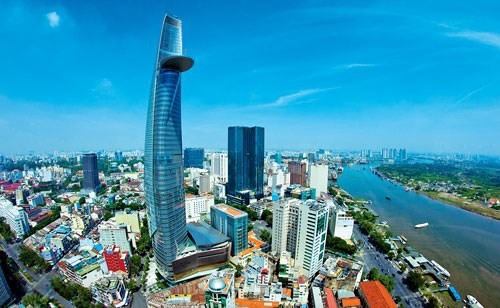 Economy
Economy

The National Assembly passed a series of new socio-economic targets this month, but some people have raised concerns about the feasibility of the goals legislators have set. Trần Toàn Thắng, director of the National Centre for Economic Forecast and Information’s World Economy Department, speaks to Việt Nam News reporter Nguyễn Hoàng Sơn about the debate.
 |
| A view of HCM CIty.— Photo cafef.vn |
The National Assembly passed a series of new socio-economic targets this month, but some people have raised concerns about the feasibility of the goals legislators have set.
 |
| Trần Toàn Thắng |
Trần Toàn Thắng, director of the National Centre for Economic Forecast and Information’s World Economy Department, speaks to Việt Nam News reporter Nguyễn Hoàng Sơn about the debate.
The National Assembly on November 8 approved the Government’s macroeconomic targets for 2019, including a goal of gross domestic product (GDP) growth of 6.6-6.8 per cent, a consumer price index (CPI) of 4 per cent, and export turnover growth of 7-8 per cent. Do you think these targets are achievable and which internal factors would impact Việt Nam’s efforts to achieve them?
The targets set by the National Assembly for 2019 are actually not too high to achieve if we look back at how the Vietnamese economy has performed since 2016. GDP growth in 2018 is estimated at 6.8 per cent, beating the target of 6.7 per cent, so the target of 6.8 per cent for 2019 is achievable.
Key factors for economic growth in 2019 include the foreign direct investment (FDI) and export sectors, which are forecast to improve. FDI capital that was registered for 2017 and 2018 will continue being disbursed for production in 2019, thus providing momentum for the nation’s economic growth.
Regarding CPI, inflation has remained stable in recent years though it has risen from 2.66 per cent in 2016, 3.53 per cent in 2017 and 4 per cent forecast for 2018. Inflation has been affected mostly by the costs of goods and services that are controlled by the Government such as education, healthcare and fuel. Other factors like cash supply, credit growth and investment have remained steady. If the Government is able to keep those factors steady, it would be feasible for it to keep CPI in the 4-5 per cent range for 2019.
Similarly, the growth of the FDI sector and new opportunities arising from global and regional trade developments would make it possible for Việt Nam to achieve a 7-8 per cent growth rate in exports for 2019.
Global political and economic conditions are forecast to become more volatile in 2019, including the escalation of the US-China trade tensions, Brexit, public debt and political instability in Europe, and worries about the slowdown of global economic development. What impacts will these factors have on Việt Nam and what should the Government do to make sure the economic targets set for 2019 are reached?
The Government should look at the positive and negative impacts of these events to formulate appropriate responses. Trade tensions between China and the US are forecast to continue with no end in sight, which would have a negative impact on global growth momentum, thus slowing Việt Nam and its trade partners. International organisations such as the International Monetary Fund (IMF) have cut their 2018-19 growth forecast for global economies by 0-0.2 percentage points compared to their anticipations made in April 2018.
Macroeconomic stability will be challenged by a depreciating Chinese yuan and an appreciating US dollar because of a stronger US economy. But the Government needs to pay attention to the positive impacts on the Vietnamese economy that may arise from the US-China scrap. In the third quarter, exports rose 15.13 per cent year on year, imports increased by 14.76 per cent and economic growth hit 6.88 per cent, indicating early worries about the trade war could be offset by potential opportunities that we may receive in the US and China markets.
In addition, the Comprehensive and Progressive Trans-Pacific Partnership (CPTPP) trade pact, which has been approved by the National Assembly, and the Europe-Việt Nam Free Trade Agreement (EVFTA), which should be approved soon, should have positive impacts on the Vietnamese economy. These are opportunities that should be seized so that the Government is able to review its solution to reform the domestic investment and business environment.
Some concerns have been raised about Việt Nam’s domestic business community, which is hoped to become the backbone of a strong Vietnamese economy. However, the local business community has been underrated. What should Việt Nam do to boost the performance of its private sector?
I don’t think private companies have been underrated. Recent reports on their performance, competitiveness and productivity have reflected the growth potential of the business community and the Vietnamese economy. In recent years, we have improved the “market access” factor but there are still other things that need to be done to help local companies survive and grow.
In the short term, the biggest problems for local companies are lending rates and “unofficial” expenses while productivity and technology are long-term problems. After studying a number of local companies, I see a big gap between their strategies, policies and practices. Unofficial expenses, despite remaining unknown in terms of value, are reported to be “high” by local companies. We have done the right thing by cutting unnecessary procedures but it isn’t enough.
What continues to weigh on local companies is human resources. Cutting the payroll and shaking up the organisational structure of government agencies have only helped save a small amount of money for the State budget. We haven’t done enough to encourage government officials to do their jobs whole-heartedly and honestly. When confidence levels start to drop, it is difficult for the Government to encourage local businesses to make long-term investments in technological development and application. — VNS




